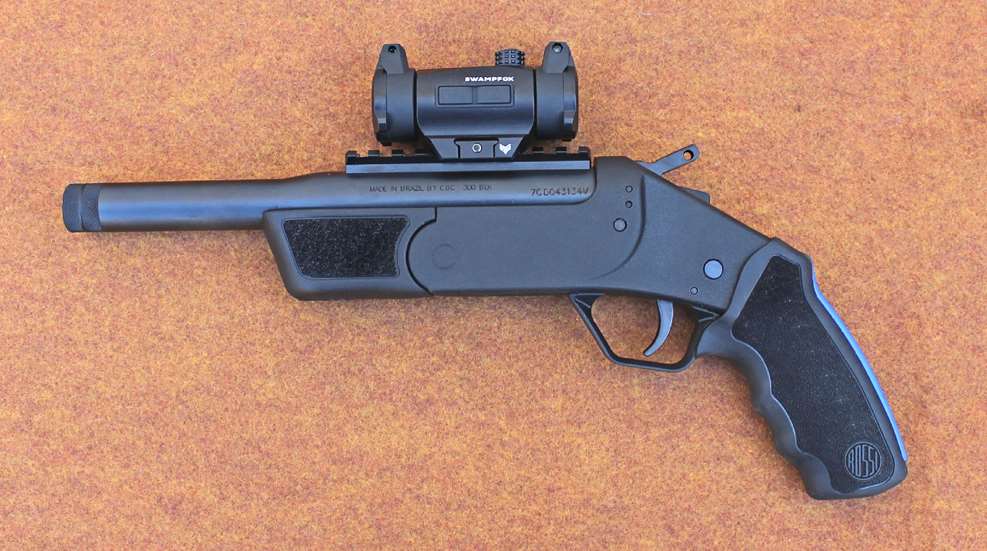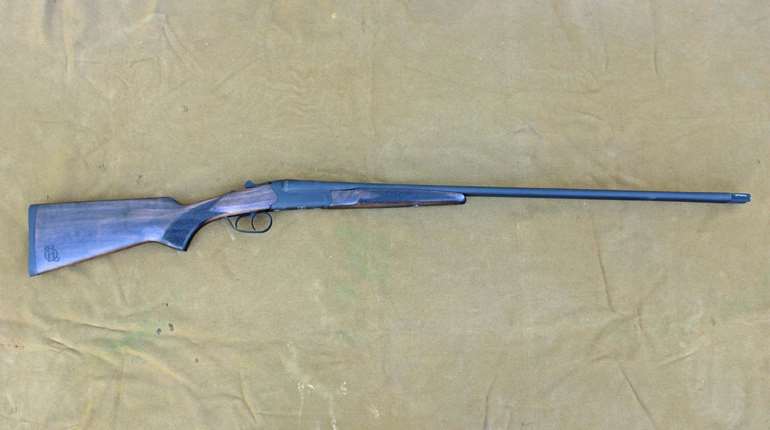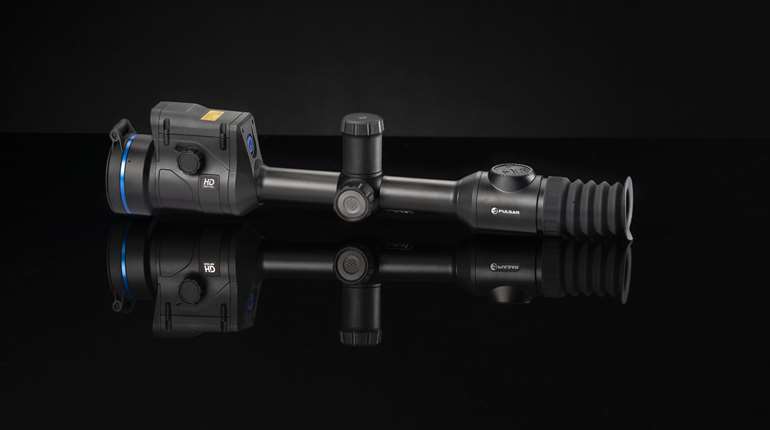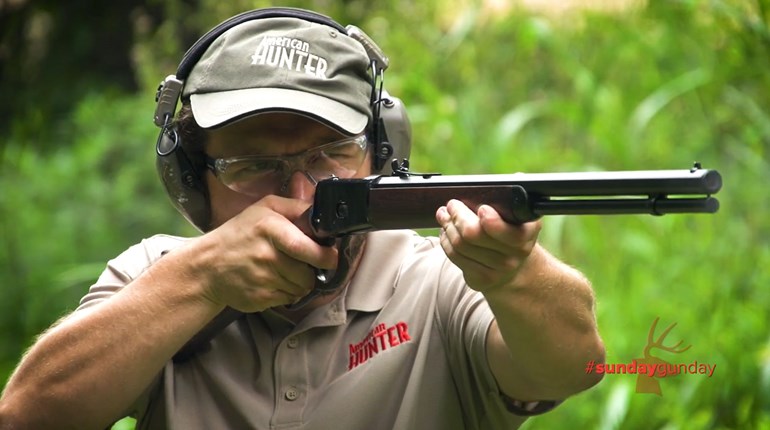
Rossi has been busily expanding its catalog of modern break-action, single-shot platforms in recent years. The first model I worked with was the SS Poly Tuffy .410-bore shotgun. It sports a black polymer receiver with molded-in steel supports at key stress points and an integral polymer trigger guard. It offers the same utility as previous all-steel receivers but with less weight and greater corrosion resistance.
As it turned out, the polymer Tuffy's receiver would serve as the key component for future models. Early in 2024, Rossi launched its .45 Colt/.410 Bore Brawler pistol. This 9-inch barrel handgun is essentially a trimmed down Tuffy with two notable changes. First, the flat-side barrel is topped with a 4-inch long 10-slot aluminum Picatinny optics rail. Secondly, the shoulder stock has been traded out for a polymer grip frame which supports a monolithic finger-grooved soft-rubber grip lifted from the Taurus Raging Hunter revolver.
 The latest version of the Brawler is chambered for rifle cartridges.
The latest version of the Brawler is chambered for rifle cartridges.
By the middle of 2024, Rossi launched a long-barreled version of the Brawler dubbed the Poly Tuffy Survival which was also chambered in .45 Colt/.410 Bore. Right around the same time as I was evaluating this model, the company was ready to start shipping a new series of centerfire single-shots called the Light Weight Carbine (LWC) series. Although their Tuffy heritage is evident in their design, the LWCs have been beefed up for caliber options including .357 Magnum, .223 Remington/5.56 NATO, .300 Blackout and 350 Legend. As of this writing, the LWC line up was expanding to include pistol-gripped models with folding shoulder stocks along with the fixed hunting-rifle stock options.
 This pistol is manufactured by Companhia Brasileira de Cartuchos (CBC) in Brazil and imported by Rossi USA.
This pistol is manufactured by Companhia Brasileira de Cartuchos (CBC) in Brazil and imported by Rossi USA.
With the original Brawler and the LWC models in full swing, Rossi had developed all of the components needed to branch out into rifle-caliber single-shot pistols. Launched in 2025, the latest version of the Brawler is available chambered in either .223 Rem./5.56 NATO or .300 BLK. This evaluation takes a closer look at the .300 BLK version.
 The Swampfox Liberator II rifle red-dot was an ideal fit for this gun.
The Swampfox Liberator II rifle red-dot was an ideal fit for this gun.
Like other members of its family, this Brawler is a single-action single-shot manufactured for Rossi by Companhia Brasileira de Cartuchos (CBC), which is a Brazilian manufacturer based in Ribeirão Pires, São Paulo. The 9-inch long round-profile barrel with its beefy chamber is simply a shorter version of that found on the LWC. Its features include a muzzle threaded at 5/8x24 TPI with a knurled thread protector, an aluminum optics rail and spent cartridge extractor. However, this model omits the fixed sights found on the .45 Colt/.410 Bore version. But considering the extended shooting range of the rifle-caliber versions, folks are likely to install either a magnified handgun hunting scope or a red-dot optic.
 The beefy break-action chamber provides plenty of support for the .300 BLK cartridge.
The beefy break-action chamber provides plenty of support for the .300 BLK cartridge.
The stubby fore-end is made from black polymer with molded-in aggressive texturing on both sides. This Brawler is notably heavier than its predecessor with an unloaded weight of 60.5-ounces. Although this handgun can be fired with both hands wrapped around its revolver-style grip, it will be more comfortable for some shooters to move their support hand forward to hold the textured fore-end to help balance the weight, especially with a sound suppressor installed.
 The right side release lever allows the action to swing open for loading.
The right side release lever allows the action to swing open for loading.
The exposed hammer for this model is thicker so that it can be drilled and tapped for a removable and reversible hammer extension. This type of extension is helpful to have when using a magnified scope that extends out and over the serrated hammer spur, since the hammer has to be manually cocked for each shot fired. In this case, the pistol was fitted with a rifle-style Swampfox Liberator II red-dot (RDLR122-2RD; $149) using the short-height T-2 footprint mount provided with the optic. Since it was compact enough to not interfere with thumbing back the hammer, the extension was not installed. This optic configuration also proved to be a just-right height for use with a suppressor.
 The big-bore revolver-style grip successfully tames felt recoil.
The big-bore revolver-style grip successfully tames felt recoil.
The barrel release is a grooved polymer lever located to the right of the hammer. When pressed downward, the barrel can swing down in order to expose the chamber for loading and unloading. The crossbolt-style button safety is located between the barrel release and the trigger. When in the Safe position, it blocks the hammer from being cocked. When in the Fire position, it protrudes from the left side of the receiver with a visible red-ring indicator. This safety can be engaged when opening or closing the action.
 The polymer receiver features steel inserts at key locations making it durable and lightweight.
The polymer receiver features steel inserts at key locations making it durable and lightweight.
The single-stage trigger is an untextured, gently curved steel bow. The trigger of the pistol sent for this evaluation was firm and creep-free before breaking cleanly with 4-pounds 5-ounces of trigger pull. The trigger swings about 0.5-inches to complete the arch of travel. It proved to be enjoyable to work, with a smoother feel than one might expect from a pistol in this price range.
 The muzzle is threaded at 5/8x24 TPI for accessories including brakes, flash hiders and sound suppressors.
The muzzle is threaded at 5/8x24 TPI for accessories including brakes, flash hiders and sound suppressors.
With a choice between a .223 Rem. or .300 BLK to test-fire, I went with the .300 BLK version for a few reasons. Unlike the .223 Rem, this .30-caliber cartridge was designed specifically for use with shorter barrels and sound suppressors. Although it can perform quite nicely when fired from 16-inch or longer rifles, barrels between 8 to 10-inches in length generally provide a useful balance of performance and compact size for this round.
 This pistol was paired with a .30-caliber Backcountry titanium sound suppressor.
This pistol was paired with a .30-caliber Backcountry titanium sound suppressor.
Having worked with .300 BLK in a variety of platforms, I knew going into this test that it was unlikely to produce excessive levels of felt recoil. That proved to be the case. It was stout with some of the loads but, thanks to the gun's weight and the cushioning of the soft rubber grip, not punishing. Hold on to this pistol like you are touching off a hot .357 Mag. or typical .44 Magnum and you'll do just fine.
 The levels of felt recoil, muzzle flash and noise changed noticeably depending on the .300 BLK loads fired.
The levels of felt recoil, muzzle flash and noise changed noticeably depending on the .300 BLK loads fired.
But what I was really looking forward to was seeing how this pistol and the Banish Backcountry hunting rifle suppressor would work together. Featuring an all-Titanium construction, this 6-baffle, .30-caliber suppressor was a hoot to shoot with the Henry Lever-Action Supreme chambered in the same caliber. So, the Brawler was test fired with two of the same loads to see how the change in barrel affected the suppressor's performance.
 This single-shot printed similarly sized 3-shot groups with or without the sound suppressor installed.
This single-shot printed similarly sized 3-shot groups with or without the sound suppressor installed.
At the shooting range, the Brawler proved to be utterly reliable with all of the ammunition tested on and off of the shooting bench. The controls worked smoothly and properly along with all of the spent cartridge cases extracting so that they could be easily removed manually from the chamber. The factory installed optics rail screws, and those supporting the Swampfox optic, held tight and true throughout the course of testing.
The formal testing consisted of three 3-shot groups fired into paper targets posted at 25-yards. A Garmin Xero C1 Pro chronograph was used to measure bullet muzzle velocity averages for 10-shot strings. Here are those results:

After this portion of the paper punching was completed, it was time to twist the suppressor onto the muzzle. Shooting with the suppressor included one more 3-shot group with each of the loads used for formal accuracy testing. Without the suppressor, the Federal American Eagle 150-gr. full metal jacket round produced an ear-popping report with a camera flash bright muzzle flash. The Backcountry contained the flash and tamed the noise effectively with a 3-shot group of 1.29-inches.
The Black Hills Ammunition 125-grain polymer tipped Matchking was the middle man in regards to noise and flash. It quieted down nicely with the suppressor installed and printed a 2.20-inch group. But the quietest of them all, right in the Hollywood quiet range, was the Hornady Subsonic 190-grain SUB-X load. The group fired with the Backcountry tightened up to 0.95-inches with a bullet energy level that was at the low end of the .357 Mag. revolver range.
 The best individual group of 0.83-inches was fired using the Federal American Eagle Load.
The best individual group of 0.83-inches was fired using the Federal American Eagle Load.
The rifle-caliber Rossi Brawler provides an uncommon blend of simplicity, reliability and flexibility at a fair price. For handgun hunters, the .300 BLK version offers a useful way to try a rifle-caliber pistol on for size without breaking the bank. It's good fun to use as a bench-rested pistol while still being handy enough for two-handed standing shots. It's a great fit for use as a backpacking, camping, trunk or 'utility' pistol with either supersonic or subsonic ammunition. With a suggested retail price of $324.99, it's currently available for around $50 less. For more information, visit rossiusa.com.

Technical Specifications
- Type: break-action; single-shot; centerfire pistol
- Caliber: .300 BLK
- Capacity: 1 round
- Barrel: 9-inch round profile; carbon steel; 1:8-inch RH twist
- Trigger: single-action; 4-lb., 5-oz. pull
- Sights: none
- Grip: textured rubber
- Metal Finish: matte black
- Overall Length: 14-inches
- Weight: 60.5-ozs. unloaded
- MSRP: $324.99; rossiusa.com




































